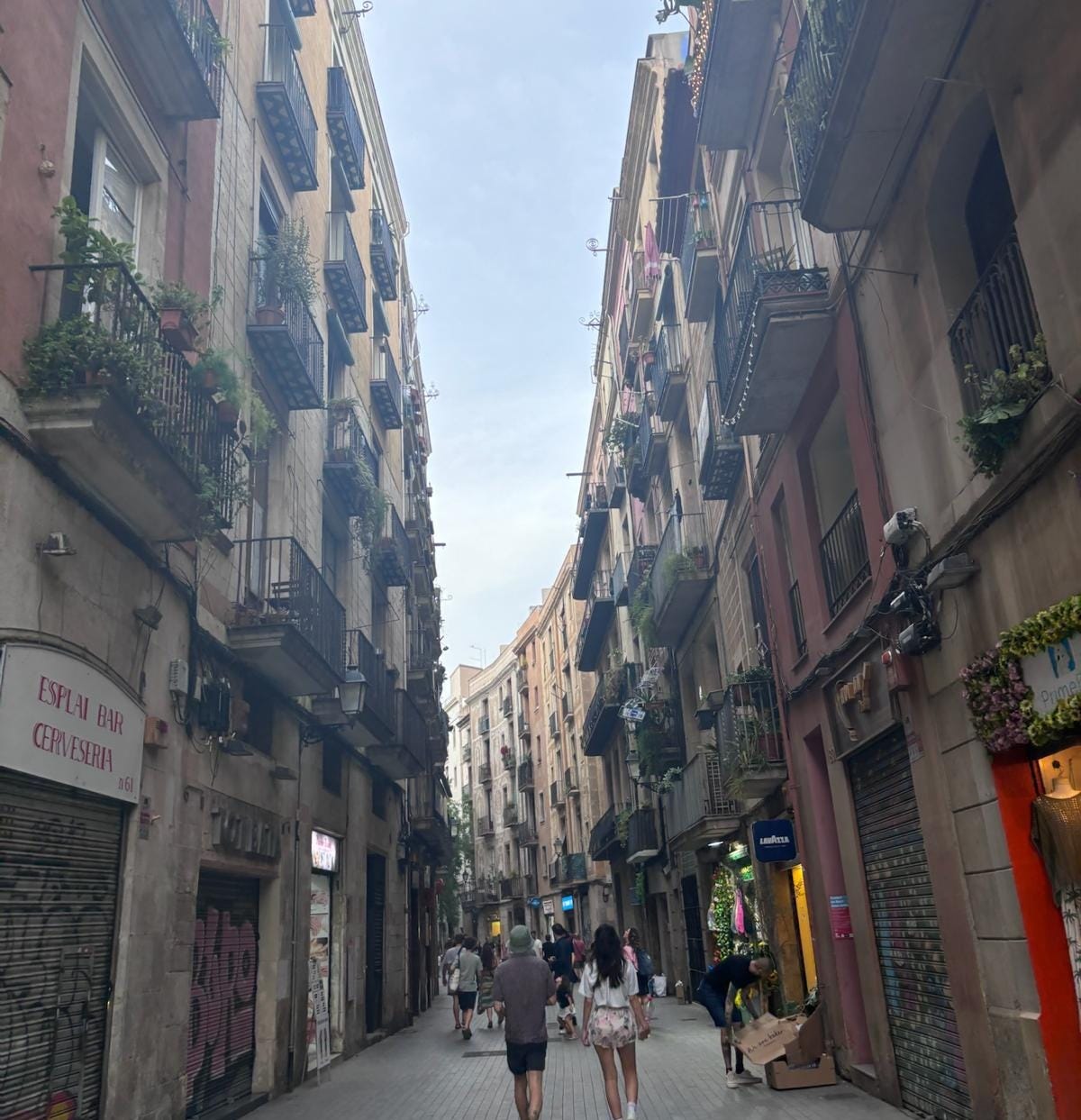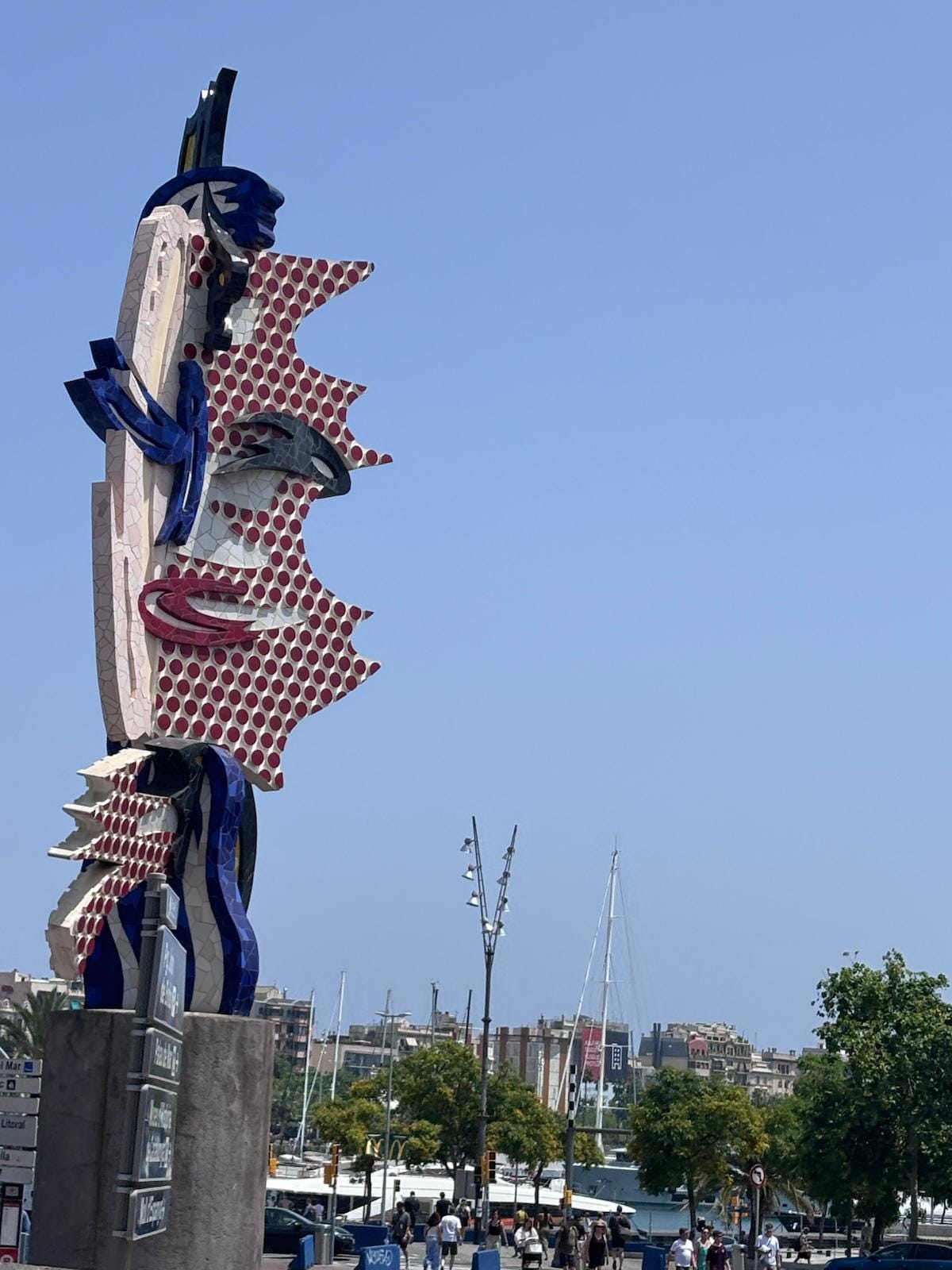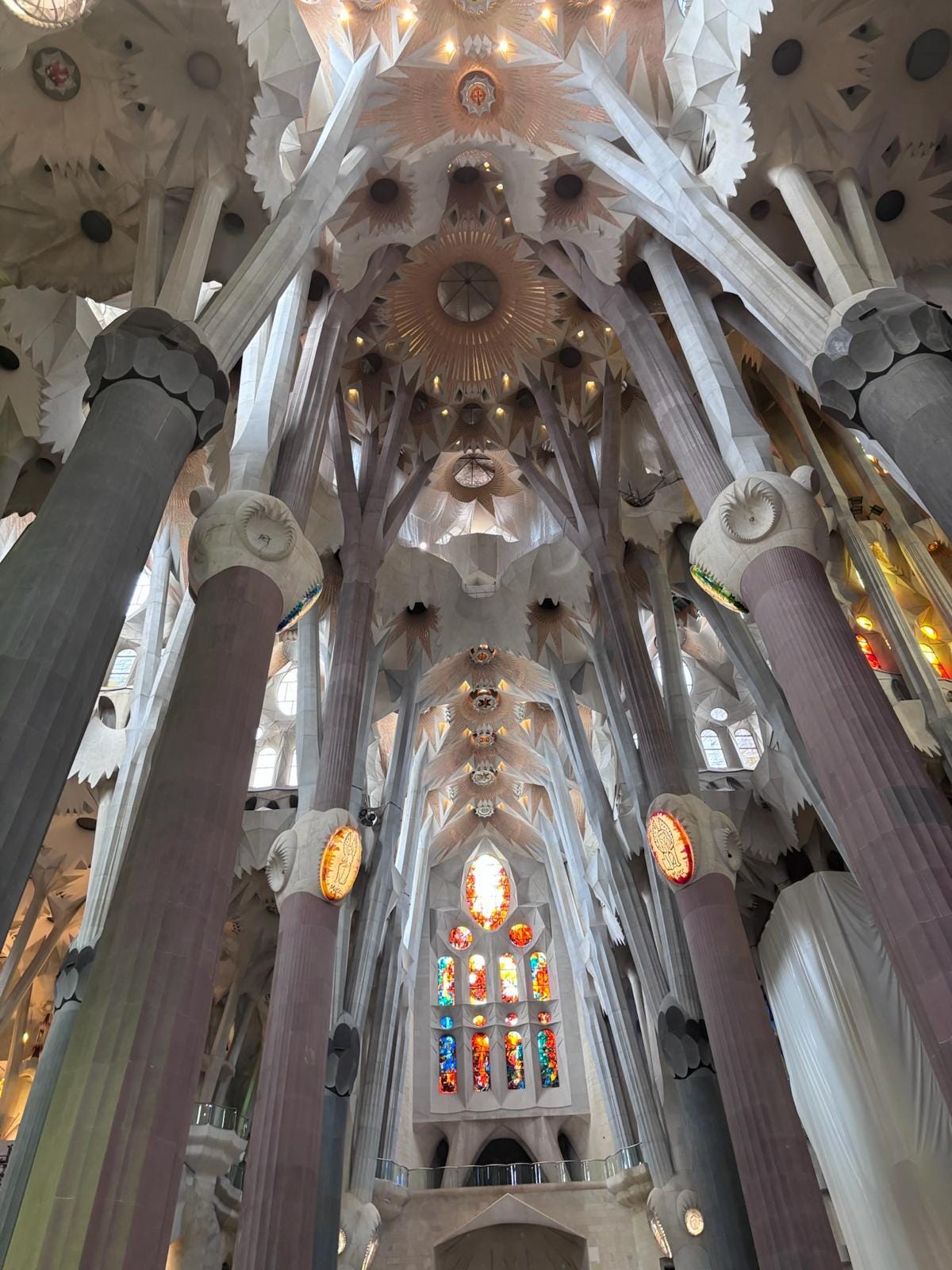You can’t get a taxi. You try twice. You give up. The sun is already high, bouncing off stone. A tourist beside you, sunburnt and cheerful, says he’s been waiting thirty-five minutes. You nod, already moving on. The streets are too full of people to wait for anything.
The gothic quarter swells with movement. You pass five souvenir shops in three blocks, all selling the same Gaudí magnets, the same mosaic lizards, the same flamenco dolls with paper fans. You don’t buy anything. But you notice the girl behind the counter — earphones in, chin in palm — watching the river of bodies pass like she’s waiting for the tide to turn.
Above the stalls, the buildings lean. You’ve read that some are older than the Americas. You believe it. They tilt into the streets like old men with secrets. You walk under their shadows.
Barcelona feels stretched thin. It wants to be lived in, but it’s being visited instead. A city once known for trade — for ships, salt, textiles — now traffics in nostalgia. You can still smell the sea if the wind is right, but mostly you smell sunscreen and hot pastry.
A bread shop down a side alley smells of yeast and stone. Locals duck in quickly, nodding to each other but not lingering. No sign. No music. Just bread. You pass it twice before realizing it’s open.
The waiter at the café is kind, then blunt. “Don’t leave your phone on the table,” he says. “They will take it.” You slide it into your bag. He doesn’t say more. But you get the sense he could.
There’s a vegan restaurant you find by accident. Not Catalan food, not Spanish food — something else. Asian-inspired, plant-based, wildly good. No tourists, just locals who all seem to know one another. You eat slowly. No one rushes you. You feel like you’ve slipped inside something — a membrane the city keeps just for itself.
Later, on another side street, you look for a restaurant with no sign. You ask a man outside smoking where it is. He points. No words. Inside: Colombian, Costa Rican, Catalan. Each dish small, exact, like a syllable in a larger sentence. You sit near a couple who share each plate without speaking. The server smiles at them like she’s known them all her life.
You hear drums before you see the protest. Ten blocks deep, winding toward the square. But the Sardana dancers are already there, moving in their quiet ring. The protest flows around them without breaking the circle. They don’t stop. Neither do the dancers. It is the most Barcelona thing you’ve seen all day.
And then there’s the art. Not the polished museum kind, though there’s plenty of that. It’s the Lichtenstein sculpture jutting from the port, cheerful and bizarre. It should be a punchline. But it isn’t. It’s a landmark now. Like the cathedral that’s still not finished. Like the past that never fully settles.
You walk through courtyards where teenagers play fútbol barefoot and dogs dart like punctuation between tables. Mothers shout from balconies. Fathers carry groceries with practiced indifference. You pass murals layered with paint, paper, protest. One says “don’t evict the future.” You take a photo, then feel strange about it.
At the foot of Montjuïc Castle, you remember what the guide said: it once protected the city, and later, it bombed it. Same stones, different aim. You look up. It doesn’t look sorry.
At the port, Columbus still points seaward. A conqueror preserved in bronze. You think of what he began. You think of what Barcelona endured. And you wonder what kind of city builds a monument to both.
And then, as if the day weren’t already crowded enough, you reach the Sagrada Família.
You weren’t planning to go in. The line coils around the plaza, thick with bodies and selfie sticks and sun hats. You can barely see the façade — a cliff face of stone, teeming with detail. Tour groups pose in front of sculptures they can’t name. Children lean on fences. Vendors sell magnets and cold water. It is chaotic. And still, somehow, reverent.
Inside, the hush returns. Not silence, but awe in disguise. The ceiling lifts so high it disappears. Columns rise like forest trunks — straight, then branching, then flowering into light. The stained glass burns in blues and oranges. You look up and feel, briefly, unmoored.
It doesn’t feel unfinished. It feels alive. As if it’s still deciding what to become. A cathedral in progress. A monument to contradiction. Barcelona, in stone.
You sit for a long time, even with the crowd pressing at your back.
Cities are not fixed things. They absorb, they fracture, they recover. Barcelona is not what it was. But then again, it never was. It is still becoming.
And becoming is enough.
Come With Me
You’re sitting with me in the nave of the Sagrada Família, though it doesn’t feel like a church in the usual sense. We’re surrounded by thousands of tourists — cameras around necks, hats still on heads — and still, somehow, it’s quieter than any Sunday service. You can hear the shuffle of feet on tile, the faint click of shutters, the occasional throat cleared into the hush. But no one speaks above a whisper. Even the children know better.
We’re sitting still. Looking up. The columns rise like trees, thick at the base and branching out overhead in soft stone canopies. They’re not grey. You thought they would be grey. But they shift — ochre, rose, honey, dusk. The light changes them. The windows, too, stain the air in color. Blue behind you. Gold in front.
It doesn’t feel reverent exactly. It feels alive. Like the building might breathe, might go on growing after we leave.
You don’t have your notebook out yet. That’s fine. Just be here. Look up. This is the sentence before the first word. This is what writing feels like when it starts.
A Tiny Workshop — On Writing in Layers
It’s tempting to clean things up when you write. To explain what you meant. To smooth out the edges. But some truths — like some cities — are not meant to be tidy. Barcelona is protest and dance, beauty and weariness, light and weight. And it works because it doesn’t ask to be one thing.
The same can be true of your writing.
If a scene or moment in your work feels flat, ask yourself: what’s missing? Often, it’s not more detail you need — it’s the detail that doesn’t fit.
Here’s the craft move: Start by naming the obvious image. Then add its contradiction. If your character finds a quiet garden, interrupt it with sirens. If the food is perfect, have someone lose their appetite. Write joy and dislocation in the same paragraph. Let the sentence bend. This isn’t about balance. It’s about truth.
When you feel the urge to resolve, don’t. Let the contradiction breathe on the page. That’s where life sits.
Invitation to Play
Think of a place you’ve visited — recently or long ago — where your first impression was wrong.
Write the moment as you first experienced it: what you saw, felt, assumed. Then break the paragraph.
Now write what you noticed after. The thing that changed your mind. Or made it more complicated. A stranger’s gesture. A smell you couldn’t place. A protest sign next to a wedding party. Let the shift stay visible.
Don’t worry about making it cohesive. Just get both truths on the page. Let the crack show.
Try for no more than 300 words. Use short sentences if the moment feels unstable. Use long ones if you’re still thinking it through.
No polish. No fix. Just write it how it was — and how it also was.
About Me
I’m the sort of writer who likes deadlines and resents them. I believe in coffee more than clarity. I’ve written Flash, CNF, short fiction, and longer fiction, taught classes, and led workshops, but I still get nervous about opening a blank page. I think white space is a kind of genius. I think you are not wrong for hesitating.
This summer series is for you — if you write, want to write, or need to be reminded that art can begin in small, defiant scraps. I’ll be writing from the road, from café tables and slow trains and sun-warmed stone steps. You can write from wherever you are.
You’re already here. That’s enough.








Rena, I’m so pleased to have discovered you and read this marvelous essay. Your writing is like the lighting you’ve described in the cathedral—one color from behind, another straight ahead. I,too, believe in including contradictions in my prose. Thanks for the juicy, descriptive language and for the encouragement to keep doing that myself. If you’re interested, you might like to check out my latest post devoted entirely to contradictions. https://open.substack.com/pub/juliesniderauthor126/p/accepting-lifes-contradictions?r=3zlo8c&utm_medium=ios
Sounding trite, they tell authors to show not tell. You do that so well that I was back in Barcelona again, the last time being 2008. When I’m done writing this, I’m going to pull out my photos. Your writing suggestions were perfect. As I read the beginning of your piece, I was thinking, “ I should try writing like this.“ With your help, now I will. Thank you and fondly, Michael.